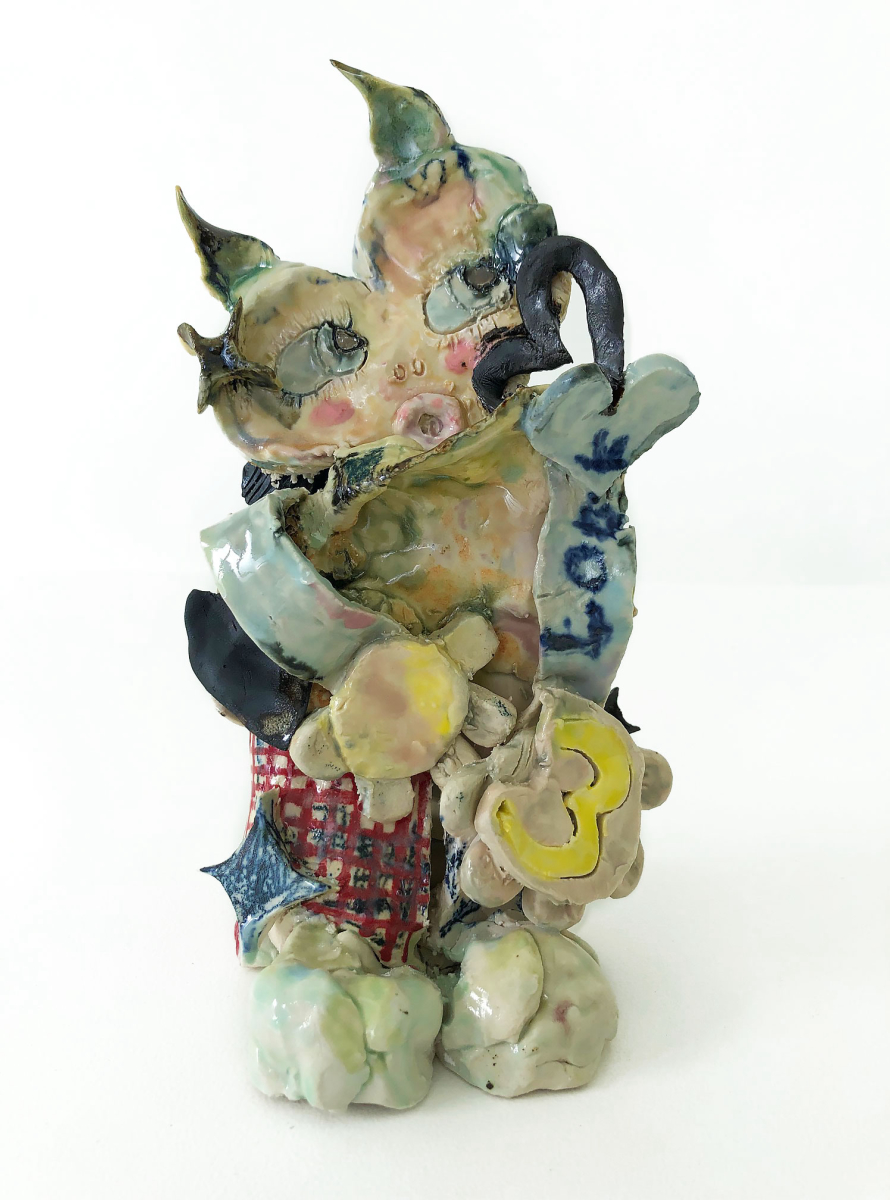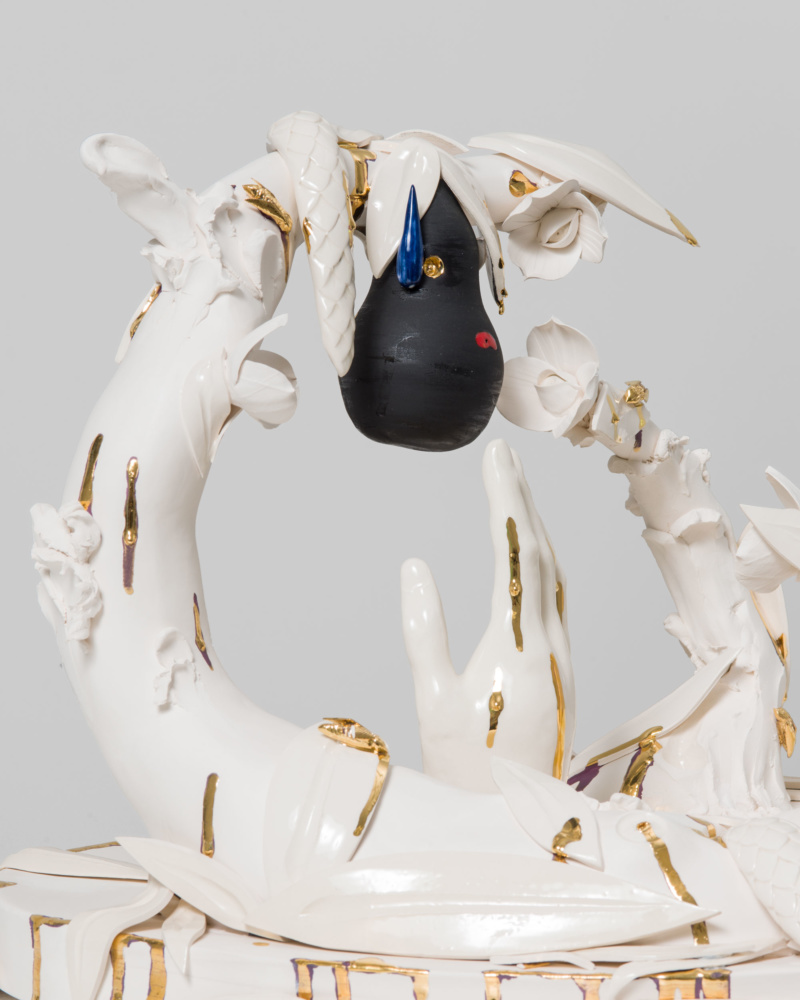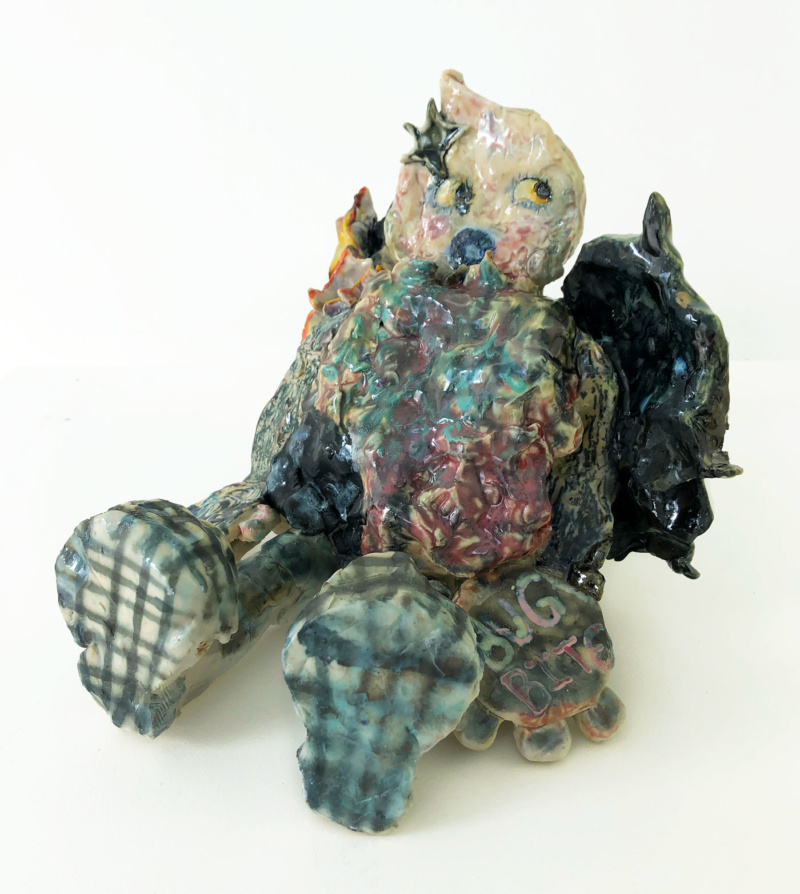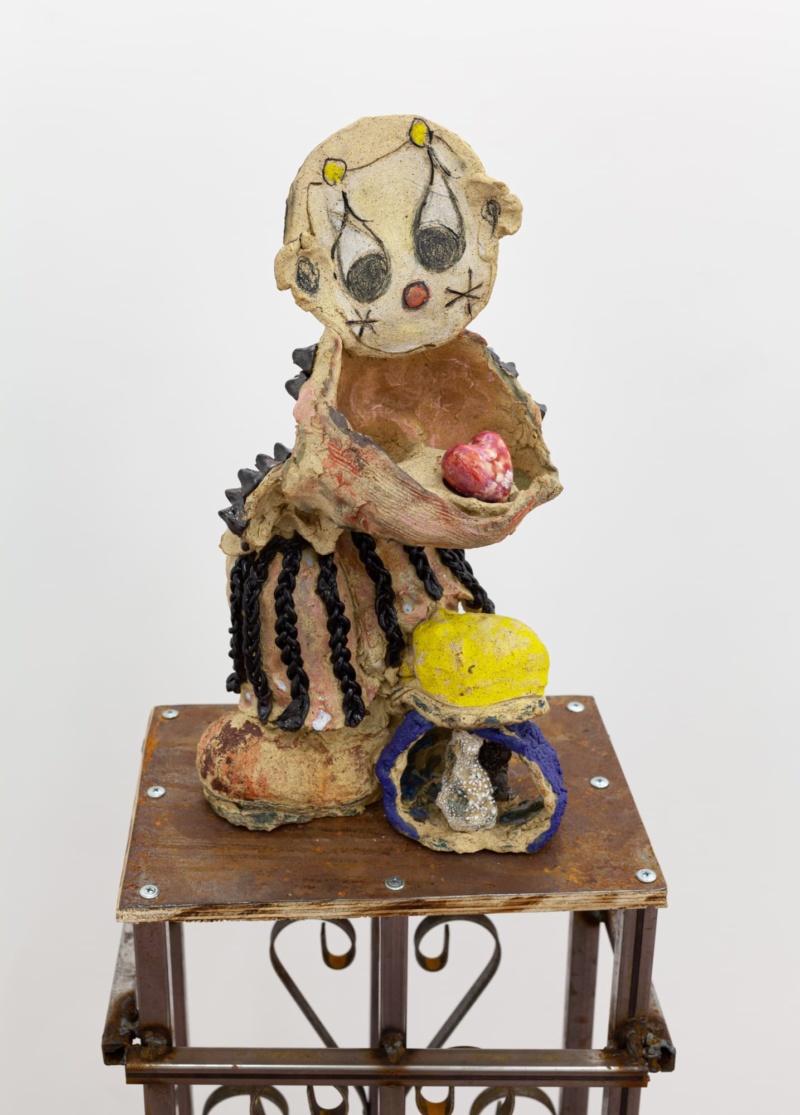
Cuteness is the first aesthetic most of us encounter in life. We are exposed to it as babies, through consumer goods, even before we are conscious of what we are seeing. Simply defined, a cute object is typically one that resembles a baby human or animal. Anthropomorphism, a strategy used since antiquity to make others, including gods, more relatable to humans, is key to cuteness’s effectiveness and requires very little to be successful. The gesture of a face combined with soft textures, rounded forms and cheerful colors produces a tender and vulnerable feeling that inspires the desire to care for and protect. Cute objects are compelling because they are approachable, but, more importantly, because they can be possessed.
We grow up accustomed to the passive comfort of these figures and we witness them come to life through the magic of animation in cartoons and films. Nevertheless, despite its strong association with the infantile, the presence and influence of cuteness in popular culture extend well beyond childhood. As described by scholar and critic Sianne Ngai in her seminal 2012 book Our Aesthetic Categories: Zany, Cute, Interesting, cuteness demonstrates “the surprisingly wide spectrum of feelings, ranging from tenderness to aggression, we harbor towards ostensibly subordinate and unthreatening commodities.” Japan’s prosperous kawaii culture has played a crucial role in catalyzing a global phenomenon. In recent years, the aesthetic of cuteness has infiltrated our Instagram feeds and commercial spaces and become integral to the style of some of today’s hottest celebrities. Ironically, as our country’s political and social landscape becomes increasingly challenging, cute aesthetics, which on the surface appear to be uncomplicated, unthreatening and friendly, are thriving; is this a form of denial or, perhaps, a coping mechanism
Significantly, cute imagery has also become prevalent in the art world as of late. Today, a generation of young American artists that includes Diana Yesenia Alvarado, Alex Anderson, Sean-Kierre Lyons, Narumi Nekpenekpen, Alake Shilling and Cristina Tufiño, embraces cuteness as a worldview particularly resonant with Millennials and Gen Z that can be critically applied as a subversive strategy to convey complicated narratives. Furthermore, they urge us to see past cuteness’s surface, which often belies a complex power dichotomy.

Since the 1990s, renowned Japanese artists Takashi Murakami and Yoshitomo Nara have notably cornered cute in the fine art market. The former made a name for himself with a wide range of art and design products featuring smiling rainbow flowers and a quirky cast of recurring characters, while the latter is known for his portraits of moody children. Notably, the former originated Superflat theory, which traces the legacy of two-dimensional artwork in Japan, from woodblock prints to manga and anime, and ties it to kawaii consumerist culture. Murakami is also an icon of Hypebeast culture in the US—a modern version of conspicuous consumption in which Millennial and Gen Z shoppers seek out prestigious and ultra-limited brands and products often popularized by influential entertainers such as Kanye West. Launched into pop-superstardom through lucrative collaborations with brands like Louis Vuitton and by designing album covers, Murakami’s practice perfectly feeds into the shallow consumerism of Superflat theory.
Ngai further explains that cuteness represents the erotization of powerlessness. Cuteness holds a complicated power dynamic fed by the feeling of dominance over the unthreatening object, which in turn exerts its own influence on the beholder. The big, watery eyes or batting eyelashes cartoon characters wield to exploit or manipulate others exemplify the latter point. While many dismiss the cute due to suspicion of its influence, the popularity of Murakami (now a multi-millionaire) attests to the inherently irresistible allure of cuteness despite being poised for rejection. However, given cuteness’s potential to manipulate, could it also be instrumentalized for harm?
While consumerism is almost inextricable from cuteness, this essay focuses on investigating the complex affective power of the aesthetic through the cultural lens of artists of color. Historically, the aesthetic of cuteness has been weaponized as a tool to oppress Black, Indigenous and People of Color (BIPOC) populations. The world of animation, in particular, has been repeatedly guilty of perpetuating negative stereotypes through the dangerously persuasive innocuousness of cuteness.

The work of Brooklyn-based artist Sean-Kierre Lyons is unapologetically cute. Their drawings of fairy-like characters dressed in funky garments composed of colorful and patterned petals are fantastical. They are also undeniably representations of Blackness. Lyons empowers their own identity, as well as that of other Black people, through figures that reimagine folkloric characters from the Southern Antebellum period and recontextualize the stylization typically associated with blackface cartoons. Black skin, large rounded red lips and big eyes: simple gestures, in use since at least the 1830s, that signal an extensive history of oppression towards Black people in the US. During the Jim Crow era especially, caricatures were critical tools of white supremacy. Used as propaganda, the imagery grossly misrepresented Black people physically, intellectually and culturally, to construct harmful stereotypes (such as an association with laziness) and to establish the myth that Black servants were happy taking care of white families.
The reality is that while most of us grew up consuming products with packaging that featured a smiling Black person—sometimes as a cute cartoon and perhaps with a catchy jingle in tow—often we are detached from the knowledge and context of what they truly represent. Take, for example, the mammy figure of Mama Inés, a large, jolly woman in a servant’s uniform and blackface who has been the mascot for Puerto Rican coffee brand Café Yaucono since the 1960s. With their sweet nature, familiar cartoons have been wildly successful anti-Black marketing logos that desensitize people from the harsh realities of being Black in America, or anywhere, and sustain systemic and internalized racism. These characters are so compelling that some people passionately defend their continued use, prioritizing nostalgia for “simpler times” (that never existed) over dismantling racist anti-Black practices.

Los Angeles-based artist Alex Anderson, who is Black and Japanese, also uses blackface in his ceramic sculptures. This strategy is particularly poignant in his work when juxtaposed with predominantly white-glazed clay. He says, “I do not think of the use of this history as a reclamation, but more as the engagement of an imposed birthright…blackface imagery is a visual distillation of a majority perception of my identity, but it also represents how I feel when I enter any white space. An awareness of the assumed truth of Black stereotypes and the feeling of potentially confirming those stereotypes, as the white gaze immediately categorizes me with implicit bias.” This fear directly informs Pearanoia (2019), a phonetic play on “paranoia.” In this work, Anderson represents himself, and Black people generally, through a cutely rendered anthropomorphic pear. The black fruit features gold dots as eyes and the typical red mouth of blackface, twisted into a frown. (Though cuteness is often thought of as optimistic, in actuality it can convey the full range of human emotions, including sadness and anger, without losing its appeal.) The pear hangs, scared, a droplet of sweat on its forehead, while a realistically rendered anonymous white hand reaches towards it and white roses with eyes look on. It is a commentary on the fetishization, consumption and exploitation of Black bodies and ideas by white people—themes the artist often explores in his practice. “Blackface in my work is a reflection of the emotional truths of navigating a white world in a black body while framing the entire circumstance as an absurdity.”
The use of cuteness and humor in Anderson’s work presents a first line of defense that parallels the code-switching expected of BIPOC communities in the US. He also incorporates Emoji iconography—a universal language that simplifies messages with cute pictographs—which has been especially embraced by Millennials and Gen Z. Anderson harnesses cuteness to create empathy towards the Black American experience and “invite grace to a subject historically contextualized as abject and other.” These approaches serve as misdirection. The sculptures make you look, draw you in and then hit you with the charged imagery of blackface, which disrupts the comfort and safety that we expect cuteness to offer. Anderson labors to soften the blow and make complex narratives more digestible for his primarily white audience, while providing a platform for dialogue about race in the US.
Lyons similarly uses cuteness subversively. Despite their child-like brightness, the artist’s figures are resilient warriors whose regalia acts like the vivid colors used by animals to warn predators that they are poisonous. Leave That Shit at Home (2020), for example, depicts one such congenial flower warrior, holding the hood of a beheaded Ku Klux Klan member. Lyons also creates soft sculptures of clouds, ladybugs, children in bunny suits and Murakami-like flowers, which likewise employ blackface. Even cuter because of their tangible softness, it is tempting to want to cuddle them. However, some of the works’ titles—You don’t want non of this Smoke and Something about this ain’t sitting right with me—remind us that they are not to be messed with.

Anderson, Lyons and Los Angeles-based artist Alake Shilling are all lovers of animation, which they cite as a significant influence on how cuteness informs their respective practices. The stories of animated characters are proxies for human experiences that help organize and digest information about the world. However, Lyons echoes the feelings of many who are deeply disappointed by representations of Blackness in the medium and brings up renowned actor and comedian Eddie Murphy’s roles in animated films as an example. Murphy has voiced two iconic animated characters: the lizard-like spirit dragon Mushu in Disney’s Mulan and the donkey in DreamWorks’ Shrek. Both are animals in films otherwise mostly populated by human-like characters. Even Disney’s first Black princess, Tiana from The Princess and the Frog, spends most of the movie either working for white people or, well, as a frog.
These movies reinforce derogatory messages within the cloak of cuteness and humor; often Black people are not only misrepresented but quite literally dehumanized. This kind of indoctrination—a type of brainwashing—has occurred for generations. Furthermore, with the lack of proper representation, Black children experience childhood very differently than white children do. This is a reminder that representation matters. It has taken Disney’s Pixar thirty-four years to produce a Black-centered story. When speaking about the plot of the upcoming release, Soul, Lyons expressed their chagrin: “Why do we need to die to get a movie?” The artist hopes to one day expand their practice into animation, of which we got a glimpse in a recent collaboration with fashion brand Collina Strada. Lyons’s “Flower Warriors” strutted the virtual catwalk for the label’s Spring 2021 collection, aptly named Change is Cute.

For Los Angeles-based artist Narumi Nekpenekpen, cuteness is a way to process personal experiences. Her sculptures, which she refers to as “bbs,” short for babies, are constructions of many individual pieces of clay that she dresses with an assortment of textures, glazes, patterns and doodles. Small in scale, these “bbs” feature cutesy faces with big rounded eyes, pretty eyelashes and either an O for a mouth or a heart for pouty lips. They serve as diary entries through which she works intuitively to process complex feelings. Sharing synergy with Nekpenekpen’s practice is Los Angeles-based Latinx artist Diana Yesenia Alvarado, who says, “the fact that looking at something cute has the ability to change our emotions or put us in a state of nostalgia is very powerful.” Alvarado’s figures instantly trigger the observer to “awww” and prompt empathy. She creates ceramic sculptures that combine her experiences with elements from her neighborhood’s architecture and vintage hand-painted advertisements. Her sculptures consist of a series of recurrent figures, including clowns and little devils, that express a range of emotions with simple mark-making. She explains, “it’s a fun challenge to try to capture an expression…the slightest change in line can truly change the entire piece.”

For Alvarado, her work is about creating a balance between vulnerability and strength, which also mirrors cuteness’s inherent dichotomy, in which something usually perceived as submissive possesses the power to influence others. Her figures will often feature faux metal studs, to indicate a punk-rock attitude, juxtaposed with the softness of tender, sad eyes in the style of Precious Moments characters. Despite some of her sculptures’ tough personas, Alvarado intends to foster connections rather than to intimidate. Similarly seeking to create bonds rather than shock is Alake Shilling. The artist, who is African American, is known for her colorful ceramic sculptures and paintings of a cast of emotive animals, from a sad cowgirl bear to a side-eyeing ladybug. It is easy to see how Hello Kitty and Lisa Frank are essential inspirations for her saturated compositions. She says, “cute is an indication of life and vitality.” Through this perspective, Shilling’s work embodies the limitless potential of youth’s pure imagination.
Growing up in Japan, Nekpenekpen, who is of Nigerian and Japanese descent, was surrounded by kawaii, but it was not until she moved to the US that she became aware of the magnitude of its reach. Yet, while she appreciates it, she does not cite it directly as a source of inspiration. Rather, Nekpenekpen is deeply influenced by Japanese artist Aya Takano’s 2001 book Hot Banana Fudge, a staple in her life since high school. Takano is a member of Takashi Murakami’s studio and of the Superflat movement; her work uses cuteness to empower women sexually. The depiction of women in cartoons as over-sexualized tropes has also been historically problematic. Some of the most recognizable female cartoons, such as Betty Boop and Jessica Rabbit, feature cute faces and voluptuous bodies and are assigned to the stereotypes of the “damsel in distress” or the “femme fatale.” Betty Boop, infamous for her baby voice, is considered the first animated sex symbol; in the words of her theme song, “she can win you with a wink, ain’t she cute?” Today, many have reclaimed this imagery to celebrate female sexuality.

The feminine and the cute are often conflated because they are both labeled as subordinate. Moreover, animated depictions of women reveal that female sexuality is considered threatening. Puerto Rican artist Cristina Tufiño uses cuteness within her sculptural practice as a feminist tool to empower women. She grew up watching the 1980s hit Brazilian children’s show Xou da Xuxa. In every episode, the eponymous host, Xuxa, landed on stage in a spaceship adorned with full red lips. She often sported no more than a bra and a short skirt. Tufiño cites these images as an influence on a feminist world of her own making.
A recurrent figure in her practice is the sphinx. She transforms the image of the ancient and feared mythological femme creature into a contemporary feminist icon of knowledge and sensuality with fashionable eyewear. Her anthropomorphic sculptural renderings are purposely simplified and painted in pastels, especially in pink, to increase their cuteness and make them less intimidating. The artist’s explorations of cuteness have also expanded to her drawing practice. In Meow 2 (2019), a wild-haired woman performs fellatio on a disembodied phallus, rendered with kitten features. This piece is part of a series focused on a fairytale in which the heroine experiences conflicting feelings of desire and aggression towards foot fetishes and gender-fluid creatures. The cuteness helps ease the anxiety of otherwise chaotic scenes and softens the taboos around sex and sexuality.
Conversely, working additively, Nekpenekpen downloads nuanced and even conflicting feelings into the clay. The artist says, “I don’t think the cuteness softens these feelings, but actually emphasizes them and allows for them to exist in the way that they do—candidly.” This complexity is paralleled by the layered quality of the sculptures, which wear elaborate outfits inspired by Japanese street style. But, she clarifies “my pieces do not exist to just be called ‘cute’ and dismissed after that.” This concern stems, in part, from the power struggle inherent to the use of “cute” in speech. The word features prominently in the lexicon of English-speakers; for Millennials and Gen Z, its employment probably verges on overuse. “That’s cute” is a go-to phrase to express approval yet lacks the effusiveness and passion of other adjectives; it can also be dismissive, signaling that something is not worthy of further consideration or merely a conversation filler. In that sense, describing work as cute might even provoke offense.
Nekpenekpen hopes that people engage her work at more than face value, given the intensive process from which her “bbs” are born, which she describes as “painful.” On the subject of dismissal, cuteness is also autobiographical for Shilling, whose naturally high voice, full of childish glee, has often been described as cute. She explains that many question the authenticity and, furthermore, the authority of her voice. Feeling a kinship with cartoons whose fictive experiences parallel her way of existing in the world, Shilling’s use of cuteness is an extension of her own identity. “I think it’s unnatural to dismiss cute. It’s human nature to be attracted to cute…cuteness is the beginning of our existence,” she explains.
This selection of artists offers but a limited cross-section of the diversity of applications cuteness has in contemporary creative practices. The wide range of perspectives underscores that cuteness is a compelling aesthetic strategy that should not be underestimated. Ultimately, although using cuteness to achieve different results, Diana Yesenia Alvarado, Alex Anderson, Sean-Kierre Lyons, Narumi Nekpenekpen, Alake Shilling and Cristina Tufiño each arrive at truths, especially those that are hard to talk about. Cuteness embodies a multitude of concepts and feelings; it can break down walls, create dialogue, help process life experiences and bring people together to encourage healing and nurturing. As demonstrated by these artists, cuteness is not a way out of the complicated sociopolitical climate we are living in, but rather a path through it. The next time you encounter the tender gaze of cuteness, dare to discover if there is more than meets the eye.










 in your life?
in your life?

